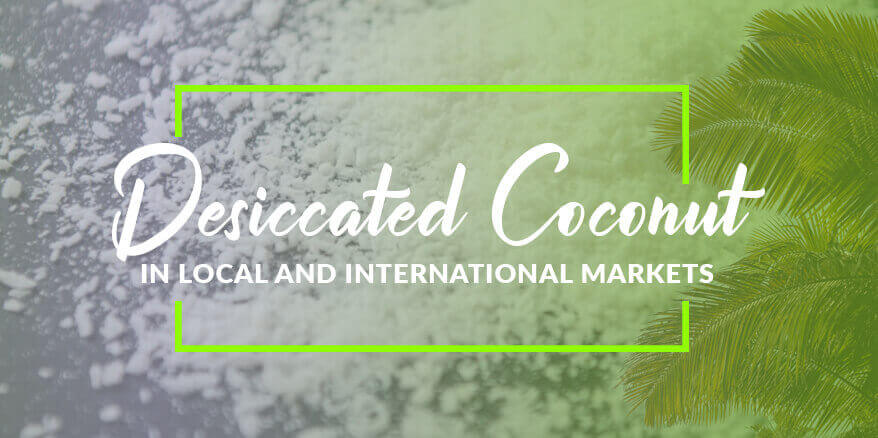Desiccated Coconut is one of the many coconut by-products that hit top sales in both local and international markets. Its presence in dishes is subtle yet it contributes a unique taste that makes several savory and sweet dishes a whole lot of excitement. Let us know what desiccated coconut is, how it performs in the local and international markets, and why it has a high demand especially in the West.
See also: Desiccated Coconut 101
What is Desiccated Coconut
Simply put, desiccated coconut is dried and grated mature coconut flesh. After harvest, mature coconuts are cracked open to drain the coconut water. Afterwards, the kernel is scraped and grated or cut depending on the requirement. The kernel is then dried within a certain temperature to achieve the standard moisture level for desiccated coconuts. The product is then packaged to reach consumers via distribution outlets such as supermarkets and online stores.
When the desiccated coconut reach consumers’ homes, it is often used as an additive in desserts like brownies and cakes. More than being a staple in most sweet confections, desiccated coconuts are also used in savory dishes such as curries.
Most of the time, people love adding desiccated coconuts into their food because it incorporates a nutty flavor that makes the dish refreshing. Little did the consumers know that adding this humble product can contribute several health benefits such as fiber, copper, manganese, and selenium.. It also contains low cholesterol, low trans-fat, and low calories which aids in weight loss if used in proper diets.
Undeniably, desiccated coconut can be present in our cuisines — from appetizers to desserts. Its presence may be understated, its flavor and its health benefits are nonetheless very much evident. This charm of the desiccated coconut makes it one of the most in demand imported products in the international market, while being much enjoyed by the locals.
See also: What to do with Desiccated Coconut?
The Desiccated Coconut Market
Since the turn of the 21st century, the demand for desiccated coconut has grown. Because coconut is a tropical fruit, tropical countries are its main producers. Southeast Asian countries such as the Philippines and Indonesia vie to be the top producer of dessicated coconut which caters to consumers prominently found in North America and Europe.
1. Philippines’ Contribution in the Desiccated Coconut International Market
The market review published by the International Coconut Community in 2018 stated that Philippines’ export volume gained strength since 2016 and became stable at the second quarter of 2017. Prices soared as high as US$2655/MT in June 2017 and balances at US$2493/MT in December 2017.
According to the Philippine Statistics Authority’s report, our export of Desiccated Coconut from January to November 2017 was 108,561 MT. This figure is a 33.7% increase than 2016’s export volume. Even though, our export and manufacturing slowed down because of the ramifications brought by El Niño and the typhoons in 2015, our local farmers and manufacturers eventually recovered after the weather became better. After recovery, we are still able to supply the needs and demanda of our international consumers.
Our neighbors in the Southeast are our tight competitors in the desiccated coconut business, particularly Sri Lanka. Though Sri Lanka is our known competitor, their high production costs became Philippines’ opportunity to enter and have a significant space in the desiccated coconut industry. This excellent performance in the industry may be caused by our agricultural scene, favorable weather, and our good commercial ties with the international market.
2. The Demand for Desiccated Coconut in the International Market
In Asia, desiccated coconut are often used as toppings in curries and other savory dishes. In Western countries, on the other hand, desiccated coconut is a staple in baking. This attitude towards the product made it one of the most in demand imports in Europe and North America. More than being a base ingredient in confectioneries, desiccated coconut is used by Western consumers in breakfast cereals and in kokosmakronen.
Most of the manufactured desiccated coconut from top producers in Southeast Asia such as the Philippines, Sri Lanka, and Indonesia end up in homes and establishments of the following countries. These are the top consumers in Europe arranged according to the highest volume of consumption:
- Belgium
- Germany
- Netherlands
While in North American region, United States is the number one consumer.
The figures and the reports mentioned here just show that desiccated coconut is well-received by consumers all over the globe. Its taste, its health benefits, its flexibility in application made our humble desiccated coconut very much craved for. So, do not get left behind the global desiccated coconut wave. Try Royce Food Desiccated Coconut!

